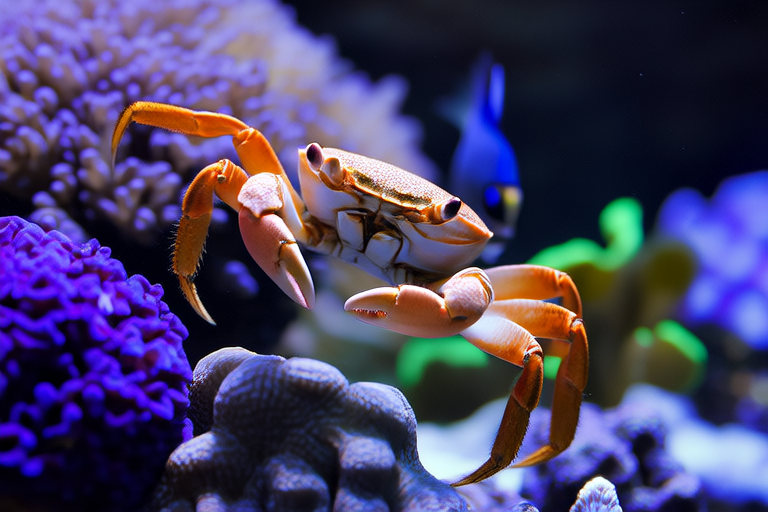The Pea Crab’s Journey: From Obscurity to Aquatic Fame
In the vast and intricate tapestry of marine life, one small inhabitant has quietly woven itself into the fabric of oceanic ecosystems: the pea crab. Despite their diminutive stature, these crustaceans have undergone a remarkable journey from obscurity to becoming a subject of fascination for marine biologists. This article delves into the unique life cycle, habitat, and symbiotic relationships of pea crabs, highlighting their transformation from lesser-known creatures to aquatic celebrities.
A Tiny Giant in the Ocean
Pea crabs, belonging to the family Pinnotheridae, are among the smallest true crabs in the world, measuring less than an inch in length. Their petite size belies their significant ecological role. These tiny crabs, often no bigger than a grain of rice, are found nestled within the bodies of bivalves such as oysters, clams, and mussels. The name ‘pea crab’ is derived from their resemblance to the humble legume, both in size and shape.
Despite their minuscule dimensions, pea crabs possess an extraordinary ability to adapt to their environment. Their translucent exoskeletons allow them to blend seamlessly with the soft tissues of their hosts, making them nearly invisible to predators. This camouflage is crucial for their survival, as it protects them from becoming a snack for larger marine creatures.
A Unique Life Cycle
The life cycle of pea crabs is as fascinating as it is complex. Adult female pea crabs enter the mantle cavity of their host, where they lay their eggs. The larvae hatch and disperse into the surrounding water, floating freely until they find a suitable host to settle into. Once inside, they undergo metamorphosis, transforming into the familiar adult form.
This intricate process of finding and settling into a host is critical for the survival of pea crabs. Host specificity varies among different species of pea crabs, with some being highly selective about the type of bivalve they choose. For instance, certain species of pea crabs are known to exclusively inhabit oysters, while others prefer clams or mussels.
Symbiosis: A Dance of Survival
The relationship between pea crabs and their hosts is a prime example of mutualism, a type of symbiosis where both organisms benefit. While the pea crab finds refuge and sustenance within its host, the host benefits from the protection provided by the crab. Pea crabs are known to consume parasites that might otherwise harm their hosts, thus acting as natural pest controllers.
Moreover, the presence of pea crabs can stimulate the growth of their hosts. Studies have shown that bivalves inhabited by pea crabs grow faster and larger compared to those without. This phenomenon can be attributed to the nutrients provided by the pea crabs’ waste products, which serve as food for the host’s tissues.
The Journey to Aquatic Fame
For centuries, pea crabs remained largely unnoticed by the scientific community. However, in recent decades, advances in marine biology and underwater exploration have shed light on these tiny creatures, propelling them into the spotlight. Researchers have been intrigued by the complexity of their interactions with their hosts and the potential implications for marine ecosystems.
The growing interest in pea crabs has led to numerous studies aimed at understanding their behavior, distribution, and impact on their environments. Scientists have also begun to explore the potential applications of pea crabs in aquaculture, given their beneficial effects on bivalve growth.
Dietary Delights
Pea crabs are omnivorous, feeding on a variety of microorganisms, detritus, and the occasional parasitic worm. Their diet is primarily composed of plankton and bacteria, which they filter from the water using specialized mouthparts. This feeding mechanism allows them to thrive in the nutrient-rich environment of their hosts.
Interestingly, pea crabs have been observed consuming the same food sources as their hosts, sometimes competing for resources. However, the delicate balance of this competition is maintained through their mutualistic relationship, ensuring that neither party suffers undue harm.
Recent Discoveries and Conservation Efforts
Recent scientific discoveries have further deepened our understanding of pea crabs. Genetic studies have revealed that different species of pea crabs exhibit distinct genetic signatures, even when inhabiting the same type of bivalve. This finding underscores the importance of biodiversity within these tiny crustaceans.
Conservation efforts have also begun to focus on protecting the habitats of pea crabs and their hosts. With the increasing threat of overfishing and habitat destruction, there is a growing need to safeguard the delicate ecosystems that support these symbiotic relationships. Initiatives aimed at sustainable fishing practices and marine protected areas are essential steps towards ensuring the continued existence of pea crabs and their hosts.
Bringing the Aquatic World to Life
The world beneath the waves is a realm of constant motion and interaction, a dance of life played out on an unseen stage. Pea crabs are but one of the many players in this grand performance, each contributing to the intricate web of life that defines our oceans. By understanding and appreciating the unique journey of pea crabs from obscurity to aquatic fame, we gain insight into the wonders of marine biology and the interconnectedness of all living things.
As we continue to explore and study these tiny creatures, let us remember the vital role they play in maintaining the health and balance of our oceans. Through conservation and responsible stewardship, we can ensure that pea crabs and their hosts continue to thrive, contributing to the vibrant tapestry of marine life for generations to come.
